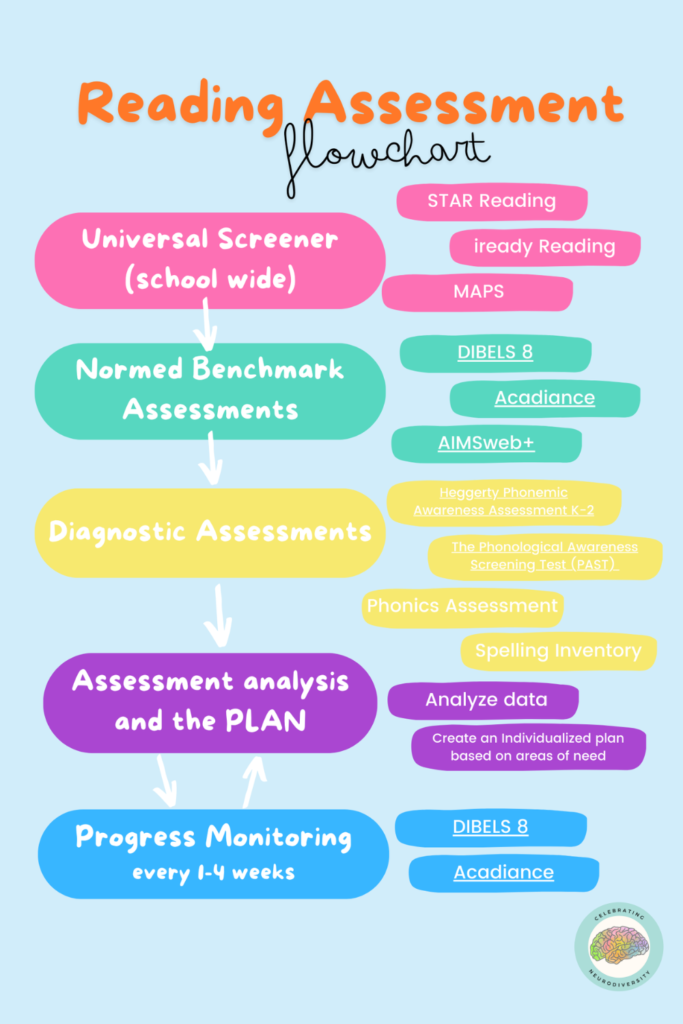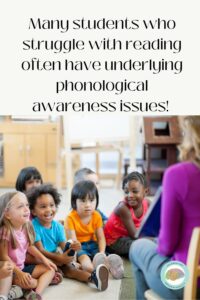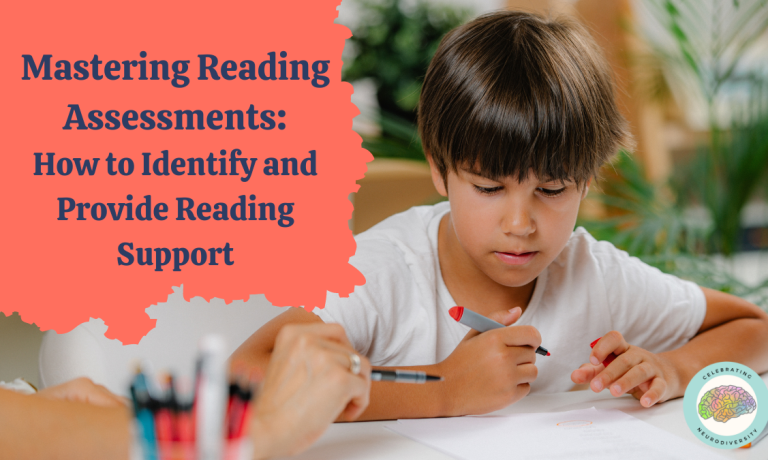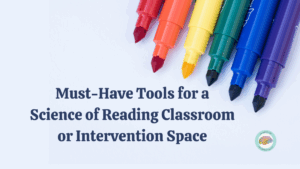As the new school year begins, finding students who need reading support is crucial. You can use various reading assessments to pinpoint which students need help and develop a plan to support their reading development. I like to use the analogy of getting sick and going to the doctor.
When you’re unwell, the first sign might be a fever. This tells you something is wrong, but you don’t know exactly what. You might go to the doctor, who listens to your symptoms. The doctor might then order blood tests to determine exactly what’s causing the problem. Once the results are in, the doctor prescribes medication and a treatment plan and schedules a follow-up to see if you’re improving. Identifying students who need reading support works much the same way. Let’s break it down step by step.

1. Universal Screeners: Identifying Those with Fevers
Just like a fever is an early sign that something might be wrong, universal screeners are the first step in identifying students who may need reading support. These assessments are designed to screen all students, identifying those who are at risk for reading difficulties.
What Are Universal Screeners?
Universal screeners are brief assessments administered to all students at the beginning of the school year. They aim to quickly identify students who may be at risk for reading difficulties, much like how a thermometer tells you that you have a fever.
Examples
Some popular universal screeners include the STAR Reading Assessment, iReady, and MAPS. These computer-adaptive tests adjust their difficulty based on the student’s responses, providing a quick yet accurate measure of reading ability.
Using Percentiles to Identify At-Risk Students
The results from universal screeners include percentile ranks, which tell you how a student’s performance compares to their peers. The default benchmark for the STAR assessment and many others include at or above the 40%ile as meeting benchmark expectations, 39-25%ile as students to watch, 24-10%ile as needing intervention, and 9%ile and below as needing urgent intervention.
For example, a student scoring at the 22nd percentile would be flagged for further assessment. I would use the normed benchmark assessments suggested below. Just as a high fever indicates a more serious problem, a low percentile rank suggests that the student might need more intensive support.
2. Normed Benchmark Assessments: Visiting the Doctor
After identifying students who might need help, the next step is to dig deeper, like when you visit the doctor because you have a fever. Normed benchmark assessments are more detailed and provide a clearer picture of a student’s reading abilities. Normed benchmark assessments are standardized tests that measure a student’s reading skills against established norms. These assessments give educators a more comprehensive understanding of where a student is as compared to grade-level expectations, just as a doctor assesses symptoms to diagnose an illness.
Free and Effective Tools
There are many quality free and paid normed benchmark assessments available. The two free options I use are DIBELS 8th Edition and Acadience Reading. Both assessments help educators identify specific areas where a student might be struggling. These assessments measure letter naming, phonics skills, phonemic awareness, word reading, and oral reading fluency.
Using Percentiles in Benchmark Assessments
Much like telling the doctor your symptoms, normed benchmark assessments help in confirming which students need more support. Percentile scores in these assessments help you understand how your students compare to national averages on specific skills, ensuring you can accurately identify those in need.
3. Diagnostic Assessments: Getting Blood Work
Normed benchmarks indicate that a student is struggling, the next step is to conduct diagnostic assessments, much like getting blood work done to pinpoint the exact issue. These assessments are designed to identify specific reading challenges so that targeted interventions can be put in place.
Introduction to Diagnostic Assessments
Diagnostic assessments dive deep into specific areas of reading, such as phonemic awareness, phonics, and spelling. They provide detailed information about where a student’s difficulties lie, much like blood tests reveal the underlying cause of an illness.
Here is a list of my favorite diagnostic assessments
Phonemic Awareness for Early Learners (K-2) I use Heggerty Phonemic Awareness Assessment: This tool is great for younger students who might struggle with phonemic awareness, a critical skill for early literacy success.
Phonological Awareness for Older Students I use the Phonological Awareness Assessment Screener (PAST). I use this assessment for 3rd graders and up.
Many students who struggle with reading often have underlying phonological awareness issues! These screeners help diagnose these issues, ensuring they receive the support they need to build a strong literacy foundation.

Phonics Assessments and Spelling Inventories
Phonics assessments and spelling inventories are essential for identifying where a student is in their phonics instruction. By assessing their ability to decode and spell words, educators can determine the appropriate starting point for instruction.
CORE Phonics Survey– assesses student’s knowledge of letter names, letter sounds, and decoding at the word level.
Words Their Way Spelling Inventory– assesses phonological and orthographic knowledge.
Phonics Assessment– I am working on an assessment that measures student knowledge of letter names, letter sounds, decoding (reading) and encoding (spelling) of phonics skills in the sequence UFLI Foundations follows. This resource will be available soon!
4. Analyzing the Data and Creating a Plan: Prescribing a Treatment Plan
Once all the assessments are completed, the next step is to analyze the data and create an instructional plan. This is similar to how a doctor prescribes medication and outlines a treatment plan after receiving blood test results.
Interpreting the Results
Carefully analyze the data to identify trends and specific areas where each student needs support. The data from the assessments provide a comprehensive picture of a student’s literacy skills, enabling you to develop a well-rounded and effective literacy plan.
Developing a Targeted Instructional Plan
Based on the assessment data, develop a targeted instructional plan for each student. This plan might include small group instruction, one-on-one tutoring, or specific interventions designed to address the student’s unique needs.
For instance, if a student struggles with H1 on the PAST, you would want to start doing the One Minute Activities for Level H1 in the Equipped for Reading Success Book. By prioritizing these activities you are helping to strengthen needed skills. When you are analyzing phonics and spelling data, think about the scope and sequence of the literacy program you are using to find the best starting point.
5. Ongoing Progress Monitoring: Follow-up appointment
Just as a doctor schedules follow-up appointments to monitor your progress, it’s essential to continuously assess students’ reading progress. Use regular progress monitoring every 1-4 weeks to ensure that the instructional plan is effective and make adjustments as needed. I use the free assessments from DIBELS 8 and Acadiance for progress monitoring.

Why Early Identification Matters
Catching reading struggles early in the year is super important for helping students succeed. By using tools like universal screeners, benchmark assessments, and diagnostic tests, teachers can figure out exactly who needs extra support and create plans that target their specific needs. Just like spotting and treating an illness early, identifying reading difficulties quickly can make a huge difference in helping students succeed.
Additional Resources
- Links to Tools and Assessments Mentioned
- Further Reading
- Equipped for Reading Success
- *I do receive a small commission from the purchases made through this link. This is at no additional cost to you.
- Related Resources








